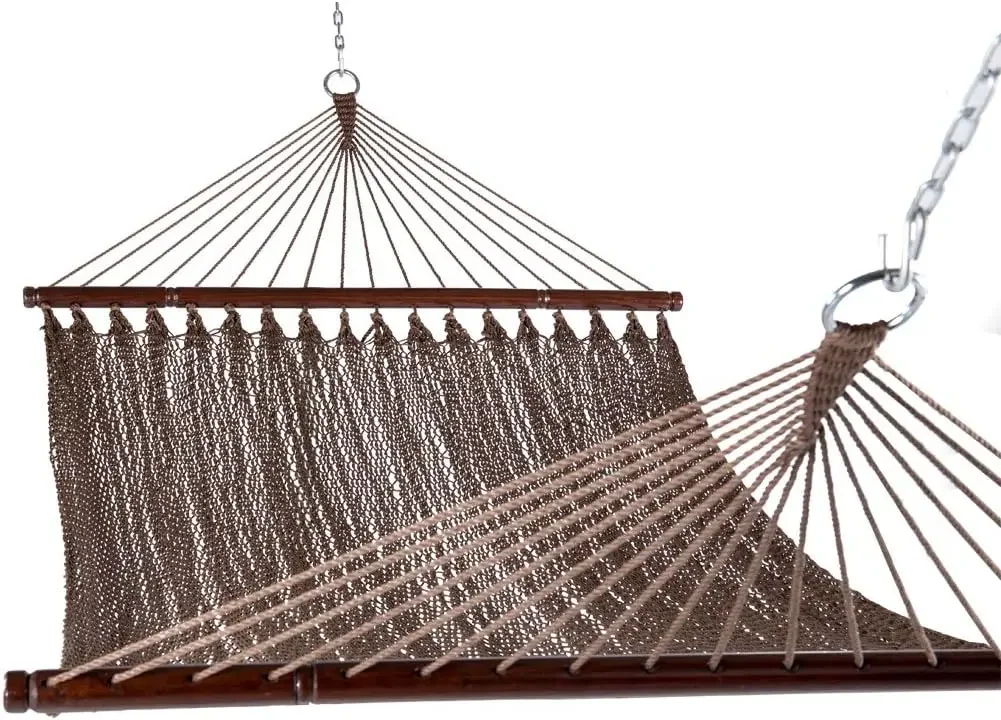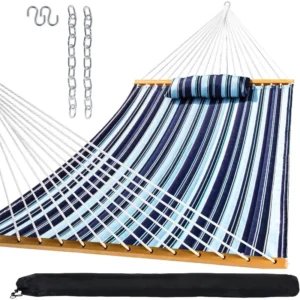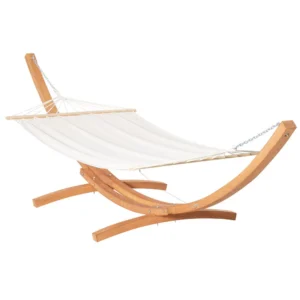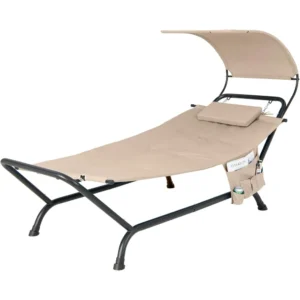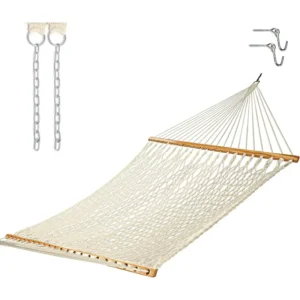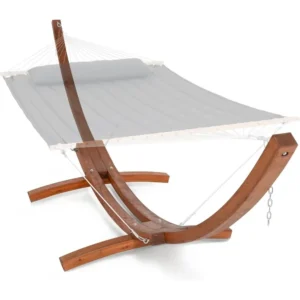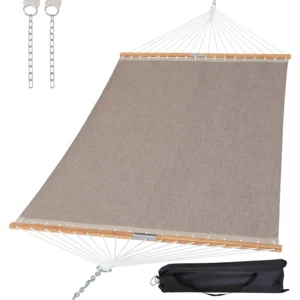Introduction: The Enduring Legacy of Classic Rope Hammocks
For centuries, rope hammocks have epitomized outdoor relaxation, combining practical craftsmanship with simple luxury. These iconic swinging beds represent more than just a place to rest—they embody a timeless approach to comfort that has weathered changing design trends and technology. What makes a rope hammock truly “classic” is its adherence to traditional construction methods, time-honored patterns, and an unmistakable sensory experience that modern alternatives struggle to replicate.
The history of rope hammocks stretches back thousands of years, originating with indigenous peoples of the Caribbean and Central America who crafted them as practical sleeping solutions. Sailors later adopted these designs for shipboard use, valuing their space efficiency and comfort on long voyages. Today, the gentle swaying motion and distinctive texture of a well-crafted rope hammock continue to offer an experience that connects us to this rich heritage.
The appeal of classic rope hammocks endures partly because of their versatile indoor-outdoor hammock placement possibilities and partly because of the unique tactile experience they provide. Unlike fabric alternatives, rope hammocks breathe naturally, creating a cooler lounging experience while the gaps between ropes gently massage the body. Their open weave allows users to feel the breeze while still providing remarkable support.
As we explore the world of traditional rope hammocks, we’ll examine the distinctive patterns and styles that have stood the test of time—from American spreader bar designs to the cocoon-like comfort of Mayan hammocks. Understanding these differences will help you select the perfect addition to your rope hammock sets collection, whether for a backyard retreat or an indoor relaxation space.
Understanding the Anatomy of a Classic Rope Hammock
Before diving into specific styles, it’s important to understand the fundamental components that make up a traditional rope hammock. Each element serves a purpose in creating the distinctive comfort and durability these classics are known for:
The Bed/Body: The main surface where you lie, typically consisting of interwoven ropes creating a supportive yet breathable net pattern.
Rope Material: Traditionally cotton, though modern versions may use polyester, nylon, or specialized weather-resistant synthetics.
Weave Pattern: The specific arrangement of rope intersections that determines strength, comfort, and aesthetic appeal.
End Strings/Cords: These gather the body of the hammock at each end and connect to the suspension system.
Suspension System: Includes rings, chains, or rope extensions that connect to hanging points.
Spreader Bars: Wooden or metal rods at each end of some hammocks that keep the hammock open and flat when hung.
Hanging Hardware: Hooks, S-hooks, chains, or other attachments that secure the hammock to trees, posts, or stands.
The presence or absence of spreader bars creates one of the most fundamental distinctions in hammock design. Traditional spreader bar hammock sets keep the hammock surface flat and open, creating an entirely different lounging experience than their non-spreader counterparts.
How these components interact determines not just how a hammock looks but how it feels when you use it. The thickness of rope, tightness of weave, and overall proportions all influence comfort, stability, and longevity—making each traditional style uniquely suited to different preferences.
American Classic: The Spreader Bar Rope Hammock
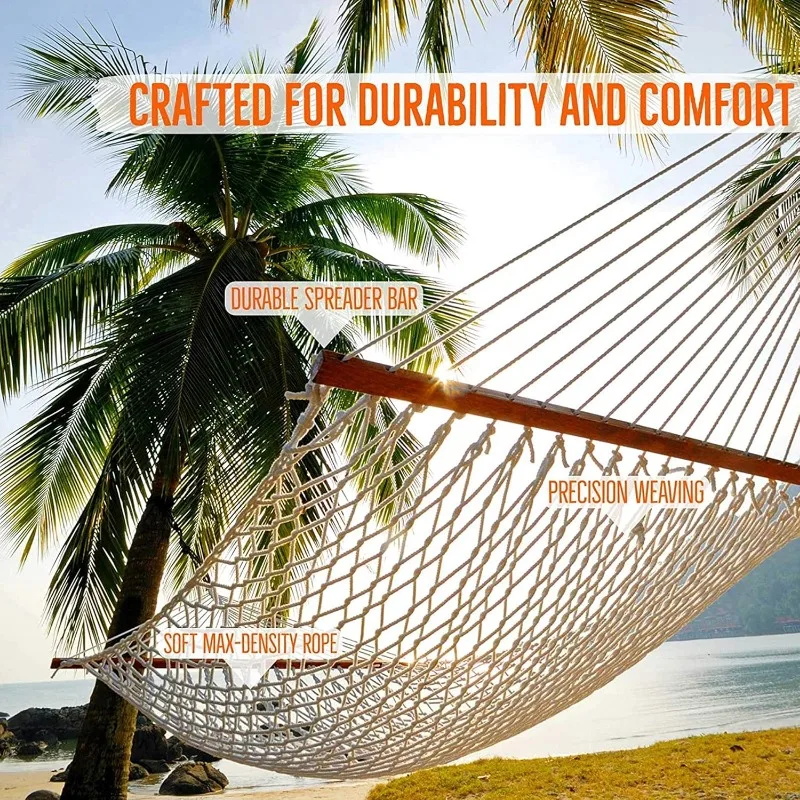
The American classic rope hammock, often called the Pawleys Island style after its birthplace in coastal South Carolina, represents perhaps the most recognizable rope hammock design worldwide. Captain Joshua Ward’s 1889 innovation transformed hammock design by introducing wooden spreader bars that keep the hammock bed open and flat—a departure from the cocoon-like hammocks used throughout tropical regions.
What makes this design immediately identifiable is its horizontal wooden bars at each end, typically crafted from hardwood that has been varnished or sealed for weather resistance. These bars maintain the hammock’s rectangular shape even when not in use, creating not only a practical lounging space but also an attractive outdoor fixture that complements garden aesthetics.
The traditional American style features a distinctive “double-latch” weave pattern where rope strands cross and interlock to create a durable lattice. Historically made from cotton rope for its softness and natural feel, many modern versions now incorporate DuraCord® or other weather-resistant synthetics that maintain the classic appearance while offering superior resistance to mold, mildew, and UV damage.
These hammocks typically measure 13 feet (4 meters) in total length with the bed portion spanning approximately 82 inches (208 cm), comfortably accommodating most adults with weight capacities ranging from 450-600 pounds (204-272 kg) for traditional two-person designs. The spreader bar creates a fundamentally different lounging experience compared to non-spreader hammocks—users lie across rather than along the hammock’s axis, with the body in a flatter position.
The appeal of this classic American design continues to influence modern hammock styles, as it represents the perfect blend of comfort and aesthetic appeal. Many outdoor enthusiasts appreciate how this design remains a timeless choice for ultimate relaxation in backyard settings, offering easy entry and exit along with its distinctive look.
Mayan Hammock Tradition: The Art of Comfort Without Spreader Bars
In stark contrast to the American style, traditional Mayan hammocks embrace a fundamentally different design philosophy—one without spreader bars. These hammocks, originating in Mexico’s Yucatán Peninsula centuries ago, feature an intricate diamond-pattern weave created from hundreds of thin strings rather than thick rope.
What makes Mayan hammocks extraordinary is their remarkable combination of strength and flexibility. The distinctive diamond-pattern weave allows the hammock to cradle the body perfectly, distributing weight evenly while allowing air to circulate. This creates a cocoon-like environment that many users find more naturally conforming to body contours than spreader bar designs.
Traditional Mayan artisans hand-weave these hammocks using a specialized technique passed down through generations. The process involves stretching hundreds of fine cotton threads between two wooden frames and meticulously interweaving them to create the characteristic diamond pattern. The density of these threads determines both the hammock’s strength and its breathability—finer, more densely woven hammocks are considered higher quality and more comfortable.
When properly hung with the right amount of sag, a Mayan hammock allows users to lie diagonally across its center, creating a remarkably flat and supportive sleeping surface despite having no rigid components. This design encourages a natural sleeping position that many find ideal for longer rest periods.
While cotton remains the traditional material of choice for authentic Mayan hammocks, modern variations incorporate nylon for additional strength and weather resistance. When choosing the best rope hammock for your needs, understanding these material differences becomes essential, particularly if you plan to use your hammock in varied weather conditions.
The visual appeal of Mayan hammocks is also distinctive—they often feature vibrant, colorful patterns that reflect their cultural heritage. Unlike American-style hammocks that function as both furniture and decoration, Mayan hammocks become nearly invisible when hung properly, with only the colorful edges visible when not in use.
Other Traditional Styles: Nicaraguan and Brazilian Rope Techniques
Beyond American and Mayan designs, several other traditional hammock styles offer unique characteristics worth exploring. Nicaraguan rope hammocks represent a fascinating middle ground between the previous styles discussed, featuring distinctive craftsmanship elements all their own.
Nicaraguan hammocks typically feature a tighter weave than their Mayan counterparts but without the spreader bars of American designs. What sets them apart are the elaborate decorative edges featuring intricate macramé work—ornamental knotting that creates beautiful fringe patterns along the sides. This decorative element serves both aesthetic and functional purposes, providing additional stability and a handhold when entering the hammock.
The body of Nicaraguan hammocks often uses a vertical string pattern rather than the diamond weave of Mayan styles, creating a different tactile experience and weight distribution. Traditional craftspeople typically use cotton for its natural feel and breathability, though modern adaptations may incorporate synthetic blends for weather resistance.
Brazilian rope hammocks take a different approach, emphasizing thick, twisted rope constructions that create a more substantial, durable feel. These hammocks originated as practical sleeping solutions in Brazil’s diverse climates and have evolved into distinctive regional variations:
- Northern Brazilian designs feature tight, fish-net style weaves perfect for hot, humid conditions
- Central Brazilian styles often incorporate thicker ropes with wider spacing
- Coastal variations frequently include colorful patterns and decorative elements
What makes Brazilian hammocks particularly interesting is their cultural integration—in many Brazilian households, hammocks remain primary sleeping accommodations rather than occasional lounging spots. This practical application has influenced their construction to prioritize durability and all-night comfort.
The ultimate guide to rope hammocks’ decorative appeal reveals how these traditional styles incorporate both functional and aesthetic elements. Each regional variation represents generations of refinement to suit specific environmental conditions and cultural preferences, resulting in subtle but meaningful differences in the final product.
The Great Debate: Spreader Bar vs. Non-Spreader Bar Designs
When choosing a classic rope hammock, perhaps no decision is more fundamental than selecting between spreader bar and non-spreader bar designs. Each approach offers distinct advantages that appeal to different relaxation styles and practical considerations.
Spreader bar hammocks provide:
– Easier entry and exit due to their flat, open design
– Enhanced visibility of surroundings while lounging
– More breathability and airflow around the body
– Attractive appearance when not in use, functioning as outdoor décor
– Better suitability for reading or activities requiring a flatter position
However, they also come with some drawbacks:
– Higher center of gravity, making them more prone to tipping
– Less adaptable to different hanging configurations
– Typically require more precise installation
– Less enveloping feeling compared to traditional designs
Non-spreader bar hammocks offer:
– Superior stability with virtually no risk of flipping
– More comfortable weight distribution and body contouring
– Greater portability and adaptability to different spaces
– Better accommodation of multiple sleeping positions
– Often higher weight capacities
Their disadvantages include:
– Steeper learning curve for finding the optimal position
– More enclosed feeling that some users find restrictive
– Less suitable for sitting upright or activities beyond resting
– Less visually striking when hung in outdoor spaces
Understanding proper hammock installation requirements and safety guidelines becomes particularly important with spreader bar designs, as improper hanging can increase the tipping risk. Non-spreader designs tend to be more forgiving with installation variations but benefit from proper tension adjustment.
Your decision ultimately depends on personal preference and intended use. Those primarily seeking a decorative outdoor lounging spot for occasional use might prefer the classic American spreader bar style. If you’re looking for a primary sleeping space or maximum comfort for extended relaxation, a non-spreader Mayan or Nicaraguan style might better suit your needs.
Weave Patterns and Their Impact on Comfort and Durability
The weave pattern of a classic rope hammock isn’t merely decorative—it fundamentally affects how the hammock performs, feels, and lasts. These traditional patterns represent generations of refinement to balance support, comfort, and longevity.
In American-style hammocks, the double-latch weave creates a grid-like pattern of perpendicular ropes. Each intersection features a distinctive knot that prevents slippage while distributing weight evenly across the entire surface. Thicker ropes (typically ¼-inch diameter) are spaced approximately 1-2 inches apart, creating substantial gaps that enhance airflow but require more total rope strength to support equivalent weight.
Mayan diamond weaves take a different approach, using many more strands of much finer material. Hundreds of thin strings create a net-like surface with thousands of intersection points, distributing weight across many more contact points. This approach requires less strength from each individual strand but creates a more conforming surface with smaller gaps. The diamond pattern allows the hammock to expand horizontally when weight is applied, enhancing its ability to cradle the body.
Nicaraguan vertical string patterns feature predominantly parallel cords with perpendicular stabilizing strands at regular intervals. This creates a distinctive visual pattern while providing directional strength—the hammock stretches more in one direction than the other, influencing how it conforms to the body.
The density of these weave patterns directly impacts:
- Weight capacity: Tighter weaves with more rope generally support more weight
- Comfort feel: Wider spacing feels more breathable but creates more pressure points
- Weather performance: Tighter weaves often shed water more effectively
- Longevity: Different patterns distribute stress differently as materials age
Skilled hammock makers understand that knot placement is as important as the weave pattern itself. Strategic reinforcement at high-stress points can dramatically extend a hammock’s usable life, particularly in designs intended for daily use or multiple users.
Rope Materials: Traditional vs. Modern Options
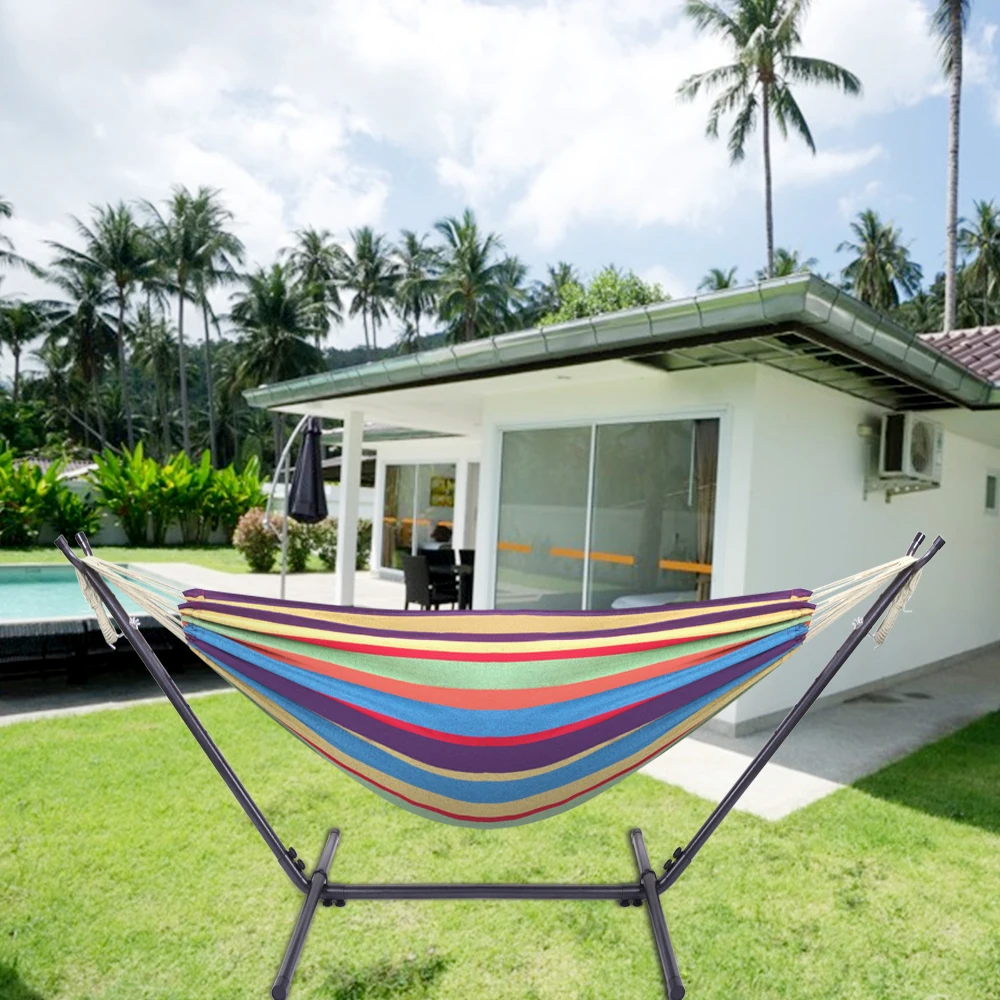
The material choice for a classic rope hammock significantly impacts its feel, durability, and maintenance requirements. Traditional and modern options each offer distinct advantages worth considering.
| Material | Feel | Weather Resistance | Maintenance | Longevity |
|---|---|---|---|---|
| Cotton | Soft, natural texture with slight give | Poor resistance to moisture, UV damage | Requires regular cleaning, indoor storage during wet weather | 2-5 years with proper care |
| Polyester | Moderately soft with minimal stretch | Good resistance to moisture, moderate UV protection | Minimal cleaning, can remain outdoors longer | 5-8 years average |
| Nylon | Smooth with noticeable elasticity | Excellent moisture resistance, fair UV protection | Easy cleaning, quick drying | 3-7 years depending on exposure |
| DuraCord® | Cotton-like feel with minimal stretch | Superior resistance to weather, mildew, rot | Minimal maintenance, can remain outdoors seasonally | 7-10+ years with normal use |
Cotton represents the traditional choice for authentic hammocks, offering an unmatched natural feel against the skin and gentle flexibility that creates a perfect cradle. However, cotton’s susceptibility to mold, mildew, and UV degradation makes it less practical for permanent outdoor installation in most climates.
Modern synthetic options have evolved significantly, with premium materials like DuraCord® specifically engineered to mimic cotton’s soft texture while dramatically improving weather resistance. These materials maintain their strength and appearance through repeated exposure to elements that would quickly degrade traditional fibers.
Beyond feel and durability, material choice affects the hammock’s acoustic properties—the subtle sounds it makes as you adjust position or sway gently. Cotton produces a distinctive soft creaking, while synthetics tend to be quieter but lack some of that authentic sensory experience.
For those seeking traditional appeal with modern practicality, double two-person hammock sets made from advanced materials offer the best of both worlds. These designs maintain classic appearances while incorporating weather-resistant fibers that dramatically extend their usable outdoor life.
The development of colorfast synthetic fibers has also expanded aesthetic options beyond the natural cotton white or ecru, allowing hammocks to incorporate vibrant colors and patterns without sacrificing durability or weather resistance.
Hanging Your Classic Rope Hammock: Essential Techniques
Proper hanging technique transforms a beautiful rope hammock into a perfectly comfortable lounging space. Even the finest handcrafted hammock will disappoint if hung incorrectly.
For standard-sized classic rope hammocks, aim for:
– Distance between anchor points: 13-16 feet (4-4.9 meters) for spreader bar designs; 10-12 feet (3-3.7 meters) for non-spreader styles
– Hanging height: Approximately 18 inches (45.7 cm) from the ground to the hammock’s lowest point when weighted
– Tension adjustment: A proper 30-degree angle from horizontal to the suspension ropes/chains when weighted
The most common hanging mistake is pulling the hammock too tight. A properly hung hammock should have significant sag—this creates the stable, comfortable surface that distributes weight properly. When in doubt, allow more sag rather than less, as you can always adjust later.
For spreader bar hammocks, ensure the bars remain parallel to each other and perpendicular to the hammock’s length. Uneven hanging can cause the hammock to twist awkwardly or increase the risk of tipping.
Non-spreader hammocks require careful attention to the suspension angle. The traditional approach uses a 30-degree angle from the horizontal, creating enough curve to properly cradle the body without excessive wrapping. Too flat a hang creates pressure points, while too steep an angle makes the hammock unstable.
Finding the best indoor and outdoor hammock locations involves considering not just anchor point strength but also surrounding space. Allow at least 2 feet (61 cm) of clearance on all sides to prevent contact with walls, furniture, or other obstacles during normal swaying motion.
For temporary setups, tree straps offer a secure attachment method that protects both your hammock and the trees. For permanent installations, properly anchored hooks in structural posts or dedicated hammock stands provide reliable support for years of enjoyment.
Preserving Your Hammock’s Beauty and Function
Proper care significantly extends the life of a classic rope hammock, protecting both its appearance and structural integrity. Different materials require specific approaches to cleaning and maintenance:
For cotton rope hammocks:
– Hand wash with mild soap and lukewarm water
– Rinse thoroughly to remove all soap residue
– Hang to dry completely before storing or using
– Avoid harsh chemicals or bleach that damage fibers
– Store indoors during extended wet weather
For synthetic rope hammocks:
– Clean with mild soap and water using a soft brush for stubborn dirt
– Rinse completely with clean water
– Allow to dry fully in the sun before folding
– Inspect regularly for signs of UV damage or fraying
Address common maintenance issues promptly:
– For fraying ropes, trim loose fibers and apply clear nail polish to prevent further unraveling
– To prevent mildew, ensure the hammock dries completely between uses
– Regularly inspect all hardware for signs of rust or wear
– Apply a light coating of beeswax to wooden spreader bars annually to maintain finish
Proper seasonal storage dramatically extends hammock life. When storing for extended periods:
– Ensure the hammock is completely clean and dry
– Store loosely coiled or hanging rather than tightly folded
– Keep in a cool, dry location away from direct sunlight
– Place in a breathable cotton bag rather than plastic containers
The question of whether it’s okay to leave hammocks outside depends entirely on the materials and your local climate. Even weather-resistant synthetics benefit from protection during extreme conditions or seasonal storage in harsh climates.
With proper care, a quality cotton rope hammock can last 3-5 years of regular use, while premium synthetic versions may provide 7-10 years or more of reliable service—making them an excellent long-term investment in your relaxation.
Finding Your Perfect Match: Selecting the Ideal Classic Rope Hammock
Selecting the perfect classic rope hammock involves matching your specific needs and preferences with the right design characteristics. Consider these key factors when making your choice:
Intended primary use:
– For occasional lounging and decoration, American-style spreader bar designs provide easy access and visual appeal
– For regular napping or sleeping, non-spreader Mayan or Brazilian styles offer superior body contouring
– For reading or activities while reclined, spreader bar designs provide a flatter, more stable surface
Location considerations:
– Indoor use allows for more delicate materials like traditional cotton
– Covered outdoor areas benefit from weather-resistant synthetics with traditional appearance
– Fully exposed locations require the most durable, UV-resistant options
Climate factors:
– Humid environments demand quick-drying synthetics to prevent mildew
– Hot, sunny climates require materials with strong UV resistance
– Seasonal locations may allow for traditional materials with proper storage during off-seasons
When evaluating quality, look for these indicators of superior craftsmanship:
– Even, consistent weave patterns without irregularities
– Reinforced edges that prevent unraveling
– Solid hardware with smooth, sealed edges
– Symmetrical construction throughout
– Proper finishing at all connection points
For those seeking maximum durability, heavy duty hammock sets provide reinforced construction and higher weight capacities without sacrificing traditional appearance. These premium options typically feature thicker rope, additional reinforcement at stress points, and hardware rated for significantly higher loads.
Classic Wooden Stand Hammock Sets, Heavy Duty Hammock Sets
$1,061.68 Select options This product has multiple variants. The options may be chosen on the product pageHammock Sets with Canopy, Heavy Duty Hammock Sets
$286.31 Select options This product has multiple variants. The options may be chosen on the product pageDouble / Two Person Hammock Sets, Rope Hammock Sets
Double Traditional Cotton Rope Hammock with Extension Chains – 450 lbs Capacity for Backyard & Patio$292.98 Select options This product has multiple variants. The options may be chosen on the product pageHeavy Duty Hammock Sets, Wooden Arc Stand Hammock Sets
$878.66 Select options This product has multiple variants. The options may be chosen on the product page
Remember that higher initial investment in quality construction generally translates to greater value over time. A well-crafted classic rope hammock becomes more comfortable with age as the fibers soften and conform to your body, developing a personalized feel that mass-produced alternatives rarely achieve.
Why Classic Rope Hammocks Endure in the Modern Age

In an era dominated by synthetic materials and mass production, the enduring appeal of classic rope hammocks speaks to something fundamental in our relationship with leisure. These traditional designs connect us to centuries of human relaxation history through both their appearance and the distinctive sensory experience they provide.
The visual simplicity of a rope hammock belies its sophisticated engineering—each style represents generations of refinement to create the perfect balance of support, comfort, and durability. Modern hammocks may incorporate new materials, but the basic principles of these time-tested designs remain largely unchanged because they simply work.
What truly sets classic rope hammocks apart is their multisensory experience:
– The gentle creaking sound as the ropes adjust to your weight
– The distinctive texture against your skin as you settle in
– The visual patterns of light and shadow created by the open weave
– The characteristic swaying motion that many find deeply soothing
This sensory richness creates a relaxation experience that transcends mere function. When you recline in a traditional rope hammock, you’re participating in a leisure tradition that spans cultures and centuries—a simple pleasure that remains remarkably unchanged despite our rapidly evolving world.
The resurgence of interest in traditional craftsmanship has only strengthened the appeal of authentic rope hammocks. As consumers increasingly seek products with heritage, story, and artisanal quality, these classic designs represent a perfect blend of function and cultural significance. Their visual honesty—showing exactly how they’re constructed and how they work—provides a refreshing contrast to the hidden complexity of modern technology.
Whether hung between trees at a rustic cabin, suspended from a custom stand in a manicured garden, or installed as a statement piece in a contemporary sunroom, classic rope hammocks adapt to our changing environments while maintaining their essential character. Their timeless patterns and styles continue to define outdoor comfort for new generations of relaxation seekers.

